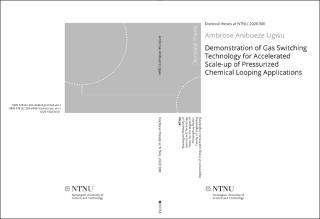| dc.description.abstract | This research focused on the experimental demonstration of Gas Switching Technology as an alternative for pressurized chemical looping. Chemical looping processes usually employ circulation fluidized bed (CFB) arrangement where metal oxides (oxygen carrier) are transported between two or more reactors in contact with different reducing and oxidizing gases. Although chemical looping technologies have enjoyed a great deal of research attention due to the proven capability of CO2 capture with minimal energy penalty, a high-pressure operation is required to achieve high process efficiency. However, pressurizing the conventional chemical looping with CFB arrangement is always challenging due to the need for precise and reliable circulation of large quantities of oxygen carrier material between interconnected reactors. Aside from the design and operational complexity created by the need to manage the solid circulation so that mass and heat are balanced within the closed-loop, the exchange of solids increases unit costs due to the additional cost of separation systems (cyclones, loop seals, etc.).
To solve these challenges, a novel gas switching Technology has been proposed in this study. Gas switching differs from traditional chemical looping in the sense that the oxygen carrier is maintained in a single bubbling/turbulent fluidized bed reactor where oxidizing and reducing gases are fed alternately without solid circulation. This simple reactor configuration can easily be pressurized and scaled up without facing unforeseen challenges. With this arrangement as well, a wide range of inlet flowrates can be accommodated, with a great reduction in variable loads since the oxygen carrier is confined in one pressurized vessel without circulation. Four chemical looping applications (combustion, reforming, water splitting, and partial oxidation). Experiments were completed using an existing lab-scale standalone reactor at the Norwegian University of Science and Technology (NTNU) which has been successfully used for demonstration of pressurized gas switching combustion of a previous project.
For the reforming demonstration, the first campaign was completed by co-feeding CH4 and H2O (steam methane reforming) in a two (fuel and air) step process for syngas (H2 and CO) production using three different iron-based oxygen carrier/catalyst (Fe/Al2O3, Fe-Ce/Al2O3, and Fe-Ni/Al2O3) at atmospheric conditions. It was observed that Fe-Ni/Al2O3 performed better than the other oxygen carriers in the reforming sub-stage, showing 40% improved methane conversion with about 75 – 80% CH4 conversion to syngas in the reforming sub-stage. This demonstration shows that CH4 conversion improves with an increase in temperature and H2O/C ratio. Autothermal operation of the reactor was also achieved with repeatable performance over several redox cycles. The second reforming demonstration was completed using Fe-Ni/Al2O3 at high pressure up to 5bar following the good performance of the oxygen carrier at first atmospheric condition. A four-stage (reduction, partial oxidation, reforming, and oxidation) process was designed to comprehensively test the behavior of the oxygen carrier towards syngas production. CH4 conversion decreased in the reforming stage as the pressure increases driven by the negative effect of pressure on both carbon gasification by steam and on the steam methane reforming. However, CH4 conversion was less sensitive to pressure at the partial oxidation stage. Carbon deposition was observed with the mechanism changing from methane cracking at the partial stage to Boudouard reaction at the reforming stage. The third and fourth demonstrations focused on the utilization of CO2 in dry reforming of methane to produce syngas for GTL applications using Ni-based oxygen. Autothermal and pressurized operations were achieved with the ability to control the syngas ratio (H2:CO) by adjusting CO2:CH4 ratio and addition of steam.
For partial oxidation demonstration, a lanthanum-based oxygen carrier was tested under the Gas Switching Partial Oxidation conditions (GSPOX) for combined syngas production and H2 production in a three-stage (fuel, steam, and air) process. At the fuel stage, CH4 is fed in the presence of a fully oxidized oxygen carrier to produce syngas (H2 and CO) with H2/CO ratio ~ 2, following the fuel stage is the steam stage where H2O is supplied to partially oxidize the reduced oxygen carrier to produce pure H2. The oxygen carrier is regenerated by complete oxidation at the air stage associated with heat generation for the process. Over 70% CH4 conversion to syngas at the fuel stage while about 30% H2O conversion to H2 (above 97% pure) was achieved at the steam stage. Despite the high reactivity and stability of this oxygen carrier, substantial carbon deposition was observed at high CH4 concentration with a resultant increase in the syngas (H2/CO) ratio beyond 2. The deposited carbon was gasified completely gasified in the steam stage making carbon deposition not an issue if syngas production is targeted. However, carbon deposition becomes an issue if pure H2 production is targeted in the steam stage due to the contamination by carbon gasification imposing additional purification measures.
For the water splitting demonstration, an iron-based oxygen carrier with 35 wt% active content was first tested under Gas Switching Water Splitting (GSWS) conditions, with good performance in terms of steam conversion to hydrogen and redox cyclability. However, gas mixing between stages affects H2 purity, CO2 purity, and CO2 capture efficiency negatively. To Maximize gas purity and CO2 capture, an iron-based oxygen carrier with a high active content ~ 75 wt% active content was manufactured and tested. The high content oxygen carrier exhibited high reactivity, but with a higher tendency to carbon deposition and agglomeration, thus creating operational challenges.
Following the successful standalone GST demonstrations, a 60kWth cluster of three reactors was successfully designed and commissioned for continuous operation of the pressurized gas switching concept. The first cluster operation of Gas Switching Combustion (GSC) using CaMnO3-δ-based oxygen carrier is still ongoing. A continuous autothermal pressurized operation is targeted at operating temperatures up to 1000 °C and pressures up to 15 bar. Further GSPOX cluster demonstration is also planned, following the good performance of the first standalone GSPOX demonstration using an optimized La-based oxygen carrier that has been shipped to NTNU. In general, all the cluster demonstrations are aimed to extract important process information to evaluate scale-up and commercialization possibilities. | en_US |
